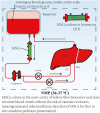Mesenchymal Stem Cell Utilization for In Vitro Donor Liver Machine Perfusion Preservation: Current Status and Future Directions
- PMID: 37643740
- PMCID: PMC10552689
- DOI: 10.1093/stcltm/szad053
Mesenchymal Stem Cell Utilization for In Vitro Donor Liver Machine Perfusion Preservation: Current Status and Future Directions
Abstract
Liver transplantation is the only effective treatment for end-stage liver disease. Currently, the shortage of high-quality donors has led to the exploration of the use of marginal organs. However, several factors limit the in vitro long-term preservation and long-distance transport of livers, which can also lead to ischemia-reperfusion injuries, resulting in poor prognosis. Therefore, an efficient and convenient strategy to improve this situation is urgently required. Normothermic machine perfusion (NMP) is expected to improve the liver environment in vitro and provide better evaluation indices for organ repair mechanisms. Mesenchymal stem cells (MSCs) can repair damaged hepatocytes or exert their protective effects via paracrine mechanisms, such as the release of extracellular vesicles (EVs). We hypothesized that combining the regenerative ability of MSCs and the significant advantages of NMP may improve the quality and utilization rate of organs, especially marginal organs. In this study, we review different strategies for liver preservation in vitro, as well as their strengths and weaknesses. We also introduce MSCs, derived EVs, and MSCs applications in liver preservation in vitro. Finally, we discuss the current challenges and future trends of MSCs applications for in vitro liver preservation. We envision novel bioreactor designs that employ 3D cell culturing and offer the possibility to reconstruct MSCs microenvironments to promote cell growth and biofunction expression. Large-scale MSCs production can be combined with normothermic machine perfusion to enhance in vitro liver preservation, thereby promoting donor organ function to benefit recipients in need of liver transplantation.
Keywords: ischemia-reperfusion injuries; liver preservation; liver transplantation; mesenchymal stem cells; normothermic machine perfusion.
© The Author(s) 2023. Published by Oxford University Press.
Conflict of interest statement
The authors declared no potential conflicts of interest.
Figures




Similar articles
-
Protective Effects of Bone Marrow Mesenchymal Stem Cells (BMMSCS) Combined with Normothermic Machine Perfusion on Liver Grafts Donated After Circulatory Death via Reducing the Ferroptosis of Hepatocytes.Med Sci Monit. 2021 Jun 11;27:e930258. doi: 10.12659/MSM.930258. Med Sci Monit. 2021. PMID: 34112750 Free PMC article.
-
Application of Mesenchymal Stem Cells During Machine Perfusion: An Emerging Novel Strategy for Organ Preservation.Front Immunol. 2021 Dec 22;12:713920. doi: 10.3389/fimmu.2021.713920. eCollection 2021. Front Immunol. 2021. PMID: 35024039 Free PMC article. Review.
-
Ex Vivo Mesenchymal Stem Cell Therapy to Regenerate Machine Perfused Organs.Int J Mol Sci. 2021 May 15;22(10):5233. doi: 10.3390/ijms22105233. Int J Mol Sci. 2021. PMID: 34063399 Free PMC article. Review.
-
Normothermic Machine Perfusion Combined with Bone Marrow Mesenchymal Stem Cells Improves the Oxidative Stress Response and Mitochondrial Function in Rat Donation After Circulatory Death Livers.Stem Cells Dev. 2020 Jul 1;29(13):835-852. doi: 10.1089/scd.2019.0301. Epub 2020 May 5. Stem Cells Dev. 2020. PMID: 32253985 Free PMC article.
-
Making Every Liver Count: Increased Transplant Yield of Donor Livers Through Normothermic Machine Perfusion.Ann Surg. 2020 Sep 1;272(3):397-401. doi: 10.1097/SLA.0000000000004198. Ann Surg. 2020. PMID: 32694447
Cited by
-
Mesenchymal stem cell therapy for liver transplantation: clinical progress and immunomodulatory properties.Stem Cell Res Ther. 2024 Sep 27;15(1):320. doi: 10.1186/s13287-024-03943-6. Stem Cell Res Ther. 2024. PMID: 39334441 Free PMC article. Review.
-
Stem Cell-Based Strategies: The Future Direction of Bioartificial Liver Development.Stem Cell Rev Rep. 2024 Apr;20(3):601-616. doi: 10.1007/s12015-023-10672-5. Epub 2024 Jan 3. Stem Cell Rev Rep. 2024. PMID: 38170319 Review.
References
Publication types
MeSH terms
LinkOut - more resources
Full Text Sources
Medical

